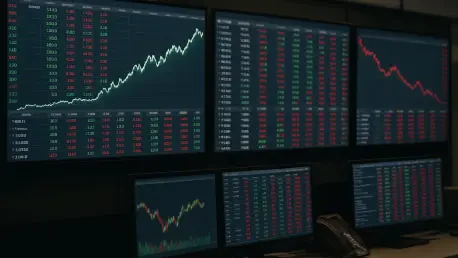The U.S. stock market has been riding a remarkable wave of optimism, with the S&P 500 skyrocketing nearly 30% since its low in April, captivating investors with the promise of endless gains. This surge, fueled by enthusiastic retail traders pouring into speculative stocks, reflects a bullish sentiment that seems almost unshakable at first glance. However, beneath this glittering surface of confidence, troubling signals are emerging. Key market indicators, alongside expert analyses, are raising red flags about the sustainability of this rally. A critical question looms large: is this a genuine, long-term boom, or are investors on the brink of a harsh reversal? As sentiment metrics flash warnings and economic fundamentals falter, the current trajectory of the market demands a closer examination to understand whether this bullish frenzy is a harbinger of growth or a prelude to a significant downturn.
Gauging Investor Sentiment
Decoding the BI Market Pulse Index
The Bloomberg Intelligence (BI) Market Pulse Index serves as a vital tool for assessing the mood of the market, combining metrics such as volatility, leverage, and market breadth into a single gauge. Currently, this index has reached a “manic” reading of 0.6, a level sustained for two consecutive months through July, signaling an alarming degree of investor exuberance. Historically, such elevated readings have been precursors to trouble, accurately foreshadowing crises like the 2023 regional banking turmoil and the 2018 slide triggered by tariff disputes. This persistent manic signal suggests that the current wave of optimism among investors might be overblown, potentially setting the stage for disappointing returns or even a sharp pullback in the near term. The index’s track record lends significant weight to these concerns, urging market participants to reconsider the risks embedded in the ongoing rally.
Beyond its current reading, the BI Market Pulse Index offers deeper insights into potential market behavior following periods of extreme sentiment, especially when this indicator hits manic levels. It often indicates that investors have become overly complacent, ignoring underlying vulnerabilities. Past instances of such readings have shown a tendency for the market to cool off, as excessive optimism gives way to caution or fear. The index’s historical reliability in spotting turning points, including the 2012 European debt crisis, reinforces the notion that the present bullish fervor could be nearing a critical juncture. While it’s not a definitive predictor of collapse, the signal prompts a reevaluation of risk exposure, especially as other economic and seasonal factors align to heighten the sense of unease among analysts and strategists tracking these patterns.
Historical Returns After Manic Signals
Examining historical data compiled by BI strategists reveals a sobering trend for markets following manic readings on the index, and this pattern raises important considerations for investors navigating the current environment. Specifically, the Russell 3000 Index, a broad measure of U.S. equities, has averaged a modest 2.9% return in the 90 days after such signals, a stark contrast to the robust 9% gain typically seen after a “panic” reading. This pattern of mean reversion suggests that the current rally, characterized by rapid gains, might soon lose steam as overextended valuations come under pressure. Small-cap stocks, in particular, could face greater challenges, potentially lagging behind larger counterparts in the S&P 500 by a noticeable margin. This historical context serves as a reminder that periods of excessive optimism often precede consolidation or declines, urging caution among those riding the bullish wave.
Delving further into these performance expectations, the disparity in returns following manic versus panic readings highlights a critical dynamic in market psychology. When sentiment is overly bullish, as it is now, investors tend to overlook risks, driving valuations beyond sustainable levels. The subsequent underperformance, as evidenced by decades of data, often stems from a collective realization that fundamentals do not support such lofty heights. For the current market, this could mean a period of stagnation or correction, particularly as other warning signs—like weakening economic data—begin to align with these historical patterns. The muted returns projected for the next three months underscore the importance of tempering enthusiasm with a pragmatic assessment of where the market stands relative to its past behavior.
Economic Realities and External Challenges
Contrasting Market Gains with Economic Weakness
While the stock market continues its impressive ascent, the broader economic landscape paints a far less rosy picture, creating a striking divergence that cannot be easily dismissed. Recent jobs reports indicate a cooling labor market, with hiring slowing and unemployment ticking upward, signaling potential fragility in consumer spending and corporate earnings. Simultaneously, a slowdown in the services sector, as reflected in private surveys, points to weakening demand in a critical area of the economy. These indicators stand in sharp contrast to the S&P 500’s relentless climb, raising serious doubts about the durability of the rally. If economic fundamentals continue to erode, the gap between market performance and reality could become unsustainable, potentially triggering a reassessment of stock valuations in the coming months.
Adding to this concern is the broader implication of a faltering economy on investor confidence over time, especially as economic indicators continue to weaken. A softening labor market often translates into reduced household income, which in turn curbs spending—a key driver of corporate profits. Meanwhile, the services sector’s slowdown suggests that businesses are facing headwinds in maintaining growth, further pressuring earnings outlooks for many publicly traded firms. This disconnect between soaring stock prices and declining economic health creates a precarious situation, where any negative catalyst could jolt the market out of its bullish complacency. As these trends persist, the risk grows that the current rally is built on shaky ground, with economic realities poised to undermine the optimism that has driven recent gains.
Policy Impacts and Global Uncertainties
Beyond domestic economic indicators, external pressures are compounding the challenges facing the U.S. stock market, with policy decisions playing a significant role in shaping the outlook. The imposition of the highest tariffs since 1934 under President Donald Trump’s administration introduces a layer of uncertainty, threatening to reignite inflationary pressures at a time when price stability is already fragile. These measures could disrupt global supply chains and increase costs for businesses, ultimately squeezing profit margins and hindering economic growth. Such geopolitical and policy-driven headwinds create an environment where sustained market gains become increasingly difficult to achieve, amplifying fears of a broader economic fallout that could drag equities lower.
Moreover, the ripple effects of these tariffs extend beyond immediate cost increases, influencing investor sentiment on a global scale. As trade tensions escalate, the potential for retaliatory measures from other nations looms large, further complicating the economic landscape. This uncertainty weighs heavily on industries reliant on international markets, casting doubt on their ability to maintain current growth trajectories. For a stock market already grappling with domestic economic slowdowns, these external factors serve as an additional burden, heightening the risk of a correction. The intersection of policy-driven challenges and global uncertainties underscores the need for vigilance, as these forces could converge to disrupt the bullish momentum that has characterized recent months.
Expert Warnings and Seasonal Patterns
Strategists Sounding the Alarm
Prominent Wall Street strategists are increasingly vocal about the risks embedded in the current market rally, with several forecasting significant downturns in the near term. Morgan Stanley’s Mike Wilson has warned of a potential 10% correction, citing overvaluation and weakening fundamentals as key concerns. Similarly, Evercore’s Julian Emanuel has gone further, predicting a 15% decline, while a team at Deutsche Bank has highlighted that a pullback is long overdue given the market’s stretched valuations. These cautionary outlooks reflect a growing consensus among experts that the bullish fervor has outpaced reality, potentially setting the stage for a painful reckoning. Their collective warnings serve as a stark reminder that the market’s upward trajectory may not be as secure as recent gains suggest.
Diving deeper into these forecasts, the rationale behind such bearish predictions often centers on a combination of technical and fundamental factors. Overvaluation, as measured by price-to-earnings ratios and other metrics, suggests that stocks are priced for perfection, leaving little room for error. Meanwhile, weakening economic data—spanning labor markets to services output—provides a fundamental basis for expecting slower corporate earnings growth. When coupled with the sheer magnitude of the recent rally, these concerns paint a picture of a market vulnerable to even minor disappointments. The consistency of these warnings across multiple firms underscores the seriousness of the situation, urging investors to brace for potential turbulence ahead.
Seasonal Weakness Adding to Concerns
Historical trends also cast a shadow over the market’s near-term outlook, particularly as the calendar approaches traditionally volatile months. August and September are statistically the weakest periods for the S&P 500, often marked by heightened volatility and notable declines. This seasonal pattern, rooted in decades of data, suggests that the current bullish momentum could face significant headwinds in the coming weeks. With investor sentiment already at manic levels, the risk of a seasonal stumble appears amplified, as any negative catalysts during these months could trigger a broader sell-off. This historical precedent adds another layer of caution for those banking on continued upward movement.
Further exploring this seasonal risk, the reasons behind August and September’s underperformance often tie to reduced trading volumes and heightened uncertainty as investors return from summer breaks. Corporate earnings reports, geopolitical developments, and macroeconomic data releases during this period can also act as catalysts for volatility, especially in an environment where sentiment is already stretched. For the current market, this timing aligns uncomfortably with other warning signs, such as the BI Market Pulse Index’s manic reading and economic slowdowns. The convergence of these factors heightens the likelihood of a downturn, suggesting that investors should remain alert to the possibility of sharp corrections during this historically challenging stretch.
Retail Behavior and Market Froth
Speculative Surge Recalling Past Manias
Retail investors have reemerged as a driving force behind the current rally, pouring capital into speculative stocks with an enthusiasm that echoes the 2021 meme stock craze. In late July, companies like Opendoor Technologies Inc. and Kohl’s Corp. experienced significant surges, fueled by this risk-on attitude among individual traders. Such behavior, characterized by a willingness to chase high-risk, high-reward opportunities, often signals that market sentiment has tipped into dangerously exuberant territory. The parallels to past periods of irrational exuberance raise concerns that the current wave of speculation could be inflating a bubble, with the potential for a sharp unraveling if sentiment shifts.
Looking at the broader implications of this retail frenzy, the focus on speculative plays often distracts from underlying fundamentals, driving valuations to unsustainable levels. During the 2021 mania, similar patterns led to dramatic spikes followed by equally dramatic crashes, leaving many retail investors exposed to significant losses. Today’s environment, with heightened social media influence and easy access to trading platforms, amplifies these risks, as momentum can build rapidly without regard for intrinsic value. This speculative excess adds to the growing list of red flags, suggesting that the market’s bullish run may be more fragile than it appears on the surface, particularly if external shocks or profit-taking emerge.
Risks of Overvaluation from Retail Exuberance
The surge in retail-driven speculation often acts as an early warning sign that the market is approaching overheated territory, where valuations detach from reality. When enthusiasm pushes stock prices beyond what fundamentals can support, as seen with recent spikes in certain speculative names, the risk of a correction grows significantly. This kind of frothy sentiment, while a boon for short-term gains, historically precedes periods of consolidation or decline, as investors eventually reassess the disconnect between price and value. The current wave of retail fervor, therefore, heightens concerns about systemic overvaluation, adding pressure to an already stretched market.
Examining this phenomenon further, the implications of retail exuberance extend beyond individual stocks to the broader market psychology. When speculative behavior dominates, it often creates a feedback loop of rising prices and increasing participation, further inflating valuations. However, this cycle is inherently unstable, as any shift in sentiment—whether from disappointing earnings, economic data, or external events—can trigger a rapid reversal. For today’s market, already grappling with manic sentiment readings and economic headwinds, this retail-driven froth represents a critical vulnerability. The potential for a sharp pullback looms large, underscoring the need for caution amid the current wave of unchecked optimism.
Balancing Perspectives and Future Outlook
A More Measured Bullish View
Amid the chorus of caution, a more optimistic perspective emerges from Ed Yardeni of Yardeni Research, who challenges the narrative of an overheated market. Pointing to a bull-to-bear ratio of 2.4 from an Investors Intelligence survey—below the decade-long average of 2.6—Yardeni argues that sentiment may not be as frothy as other indicators suggest. Instead of predicting a major downturn, he anticipates mere seasonal choppiness, suggesting that the market could weather current risks without a significant collapse. This counterpoint offers a glimmer of reassurance for bullish investors, highlighting that not all data points align with the dire warnings circulating among other analysts and strategists.
Expanding on Yardeni’s stance, his analysis underscores the complexity of interpreting sentiment metrics, as different indicators can yield conflicting signals. While the BI Market Pulse Index screams caution, the bull-to-bear ratio implies a more balanced investor mindset, potentially mitigating the risk of an immediate crash. This divergence in data suggests that the market’s path forward might not be as bleak as some fear, with room for resilience even amid seasonal and economic challenges. Yardeni’s view serves as a reminder that markets can often defy bearish predictions in the short term, providing a nuanced layer to the ongoing debate about the sustainability of the current rally.
Navigating Uncertainty with Prudence
Despite more optimistic takes, the weight of evidence—from the BI Market Pulse Index’s manic reading to economic slowdowns and seasonal risks—leans toward caution, signaling that investors should prepare for potential volatility. Historical precedents, such as prolonged manic readings in 2021 that eventually gave way to a bear market, demonstrate that markets can remain elevated for extended periods before reality sets in. This uncertainty underscores the importance of a balanced approach, where exuberance is tempered by an awareness of mounting risks. While the exact timing and severity of a potential correction remain unclear, the convergence of multiple warning signs suggests that prudence is paramount.
Reflecting on the broader landscape, the interplay of sentiment, economic conditions, and expert opinions paints a picture of a market at a crossroads, where the possibility of continued gains exists alongside the likelihood of muted returns or a pullback. This uncertainty becomes even more pronounced as historically weak months approach. Investors would be wise to monitor key indicators closely, adjusting strategies to account for the heightened risk of volatility. By maintaining a disciplined focus on fundamentals and avoiding the lure of speculative excess, market participants can better navigate the uncertain terrain ahead, ensuring they are positioned to adapt to whatever direction the market ultimately takes.









